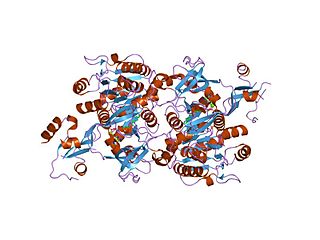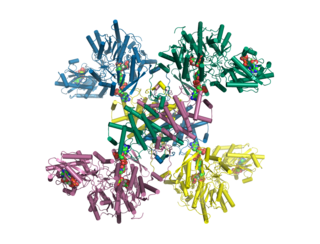 Chemical structure of phenylacetyl-CoA | |
| Names | |
|---|---|
| IUPAC name 3′-O-Phosphonoadenosine 5′-[(3R)-3-hydroxy-2-methyl-4-{[3-oxo-3-({2-[(phenylacetyl)sulfanyl]ethyl}amino)propyl]amino}-4-oxobutyl dihydrogen diphosphate] | |
| Systematic IUPAC name O1-{[(2R,3S,4R,5R)-5-(6-Amino-9H-purin-9-yl)-4-hydroxy-3-(phosphonooxy)oxolan-2-yl]methyl} O3-[(3R)-3-hydroxy-2-methyl-4-{[3-oxo-3-({2-[(phenylacetyl)sulfanyl]ethyl}amino)propyl]amino}-4-oxobutyl] dihydrogen diphosphate | |
| Identifiers | |
3D model (JSmol) | |
| 3DMet | |
| ChEBI | |
| ChEMBL | |
| ChemSpider | |
| KEGG | |
PubChem CID | |
CompTox Dashboard (EPA) | |
| |
| |
| Properties | |
| C29H42N7O17P3S | |
| Molar mass | 885.67 g·mol−1 |
Except where otherwise noted, data are given for materials in their standard state (at 25 °C [77 °F], 100 kPa). | |
Phenylacetyl-CoA (C29H42N7O17P3S) is a form of acetyl-CoA formed from the condensation of the thiol group from coenzyme A with the carboxyl group of phenylacetic acid. [1] [2]
Its molecular-weight is 885.7 g/mol. and IUPAC name is S-[2-[3-[[(2R)-4-[[[(2R,3S,4R,5R)-5-(6-aminopurin-9-yl)-4-hydroxy-3-phosphonooxyoxolan-2-yl]methoxy-hydroxyphosphoryl]oxy-hydroxyphosphoryl]oxy-2-hydroxy-3,3-dimethylbutanoyl]amino]propanoylamino]ethyl] 2-phenylethanethioate. It is formed via the actions of Phenylacetate—CoA ligase. [3]
Phenylacetyl-CoA is often produced via the reduction of ATP to AMP and the conversion of phenylacetate and CoA to diphosphate and Phenylacetyl-CoA.
- ATP + phenylacetate + CoA → AMP + diphosphate + phenylacetyl-CoA
This reaction is catalyzed by phenylacetate-CoA ligase.
Phenylacetyl-CoA combines with water and quinone to produce phenylglyoxylyl-CoA and quinol via a phenylacetyl-CoA dehydrogenase reaction acting as an oxidoreductase.
Phenylacetyl-CoA inhibits choline acetyltransferase acting as a neurotoxin. It competes with acetyl-CoA. [4]


